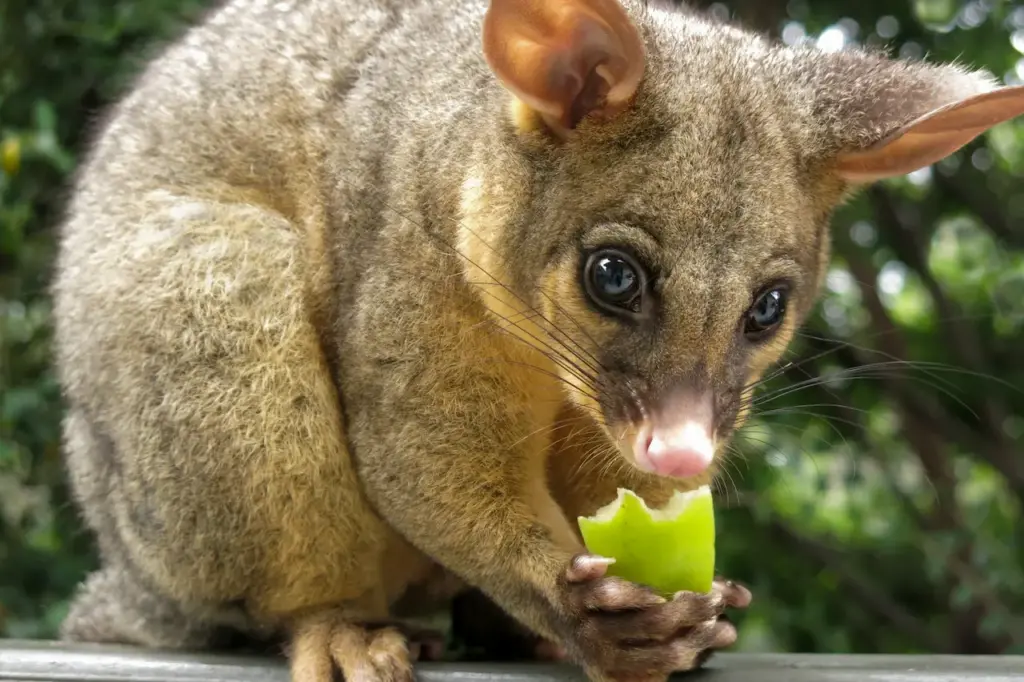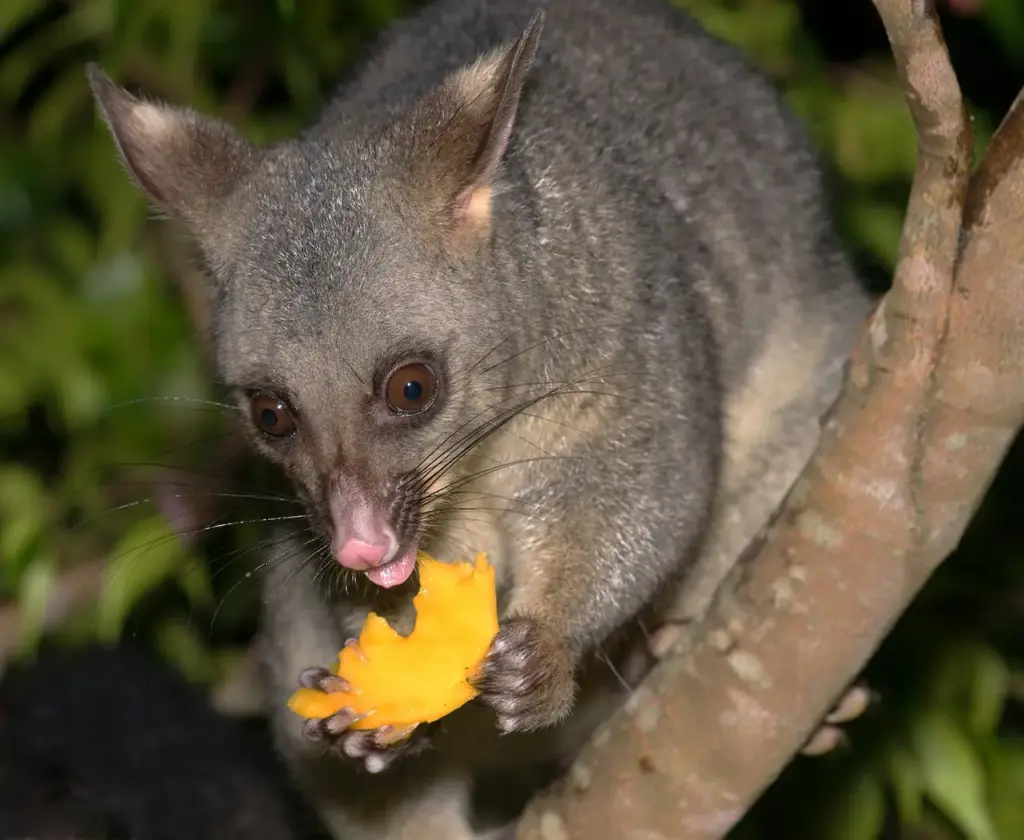Opossums or possums comprise diverse marsupial species that form part of New World and Australian ecosystems.
Although they have some means of defending themselves, possums still occupy a middle food chain level between numerous predators and their diet of smaller creatures.
As primarily nocturnal animals, possums must continually evade and occasionally outmaneuver carnivores of the night, intent on catching what they perceive as easy prey.
In this article, we will explore the various wildlife, wild canines, and even domestic animals that prey upon possums, along with their strategies and motivations for eating these ubiquitous mammalian species.

Larger Carnivorous Mammals
Numerous mammal carnivores include possums as a regular dietary supplement when the opportunity arises to capture slower individuals while they forage or travel over exposed ground. Larger mammals can easily kill an adult opossum with a quick crushing bite to the neck or head.
Bobcats
Bobcats comprise a widely distributed wild feline species throughout North and Central America known for their success in hunting small mammals and birds. Although preferring rabbits and rodents, bobcats also eat opossums, which they easily overtake on the ground.
Bobcats patrol hunting zones, watching and listening intently for signs of movement. When detecting an opossum shuffling slowly through dry leaves, the bobcat uses short bursts of speed enabled by strong hind leg muscles to close within striking distance of its target.
A quick, lethal bite to the possum’s head or neck then disables its victim, allowing for the limp body to be carried off for consumption.
Because they already eat numerous rodents, bobcats may ignore possums when small mammal numbers are high. But during leaner seasons, possums provide bobcats additional sustenance from a slower-moving meal.
This perpetual risk of attack by a patient bobcat likely helped spur the evolution of an opossum’s defensive strategy to freeze in fear and feign death when unable to outrun danger.
Coyotes
As an adaptable, opportunistic omnivore, the coyote holds reign as apex canine predator throughout much of North and Central America after wolves were exterminated in these regions.
Coyotes eat anything from berries to deer. And where their territories overlap, coyotes readily feed on possums of any size when the chance of an easy kill presents itself.
Coyotes hunt mostly alone or in mated pairs while patrolling core areas marked via urine scent posts. Utilizing acute vision and hearing, coyotes can detect possums moving at night from 80 yards away.
They approach upwind before rushing to overtake escaping possums from behind to inflict trauma to the head or spine. Solitary possums quickly become solitary meals.
Larger possums may momentarily distract attacking coyotes by growling, biting, and clawing, yet most sustain severe injuries.
More confrontations occur where expanding coyote ranges encroach upon suburbia, bringing them into closer nightly contact with urban possums seeking trash bin scraps. These incidents usually culminate with the canine victor dragging off its possum quarry to be eaten.
Feral Domestic Dogs
Like coyotes, feral and free-ranging domestic dogs maintain an inherited predisposition from wild canine ancestors to hunt, pursue, and consume mammals they can catch, including possums.
When dogs band together in stray rural packs, they can take down fairly large prey, including adult possums, using coordinated attacks.
Pack dogs chase possums up trees to trap them or pursue them on the ground by scent until exhausted as individual dogs tag in and out to diminish escape chances.
Once surrounded or caught, the lead attacking dog seizes the possum’s throat or head to crush the skull, while other dogs help immobilize it by biting limbs until it dies. They then collectively feast upon their kill, often leaving only bones and entrails scattered about.
Even solitary stray dogs will readily dispatch and eat any young or sickly urban possums they discover while prowling alleyways at night as these overweight canines pursue an atavistic impulse.
Thus, whether alone or within cunning packs, abandoned domestic dogs often revert to opportunistic predation whenever simple possum prey wanders across their paths.

Birds of Prey
All manner of birds of prey feeds upon possums wherever their habitats overlap. Several raptor groups fill specific niches, mainly pouncing upon possum prey temporarily exposed on the ground as they transition between safer covered areas.
Most attack to kill instantly with razor talons rather than prolonged aerial harassment.
Hawks & Falcons
Birds of prey under the falcon and hawk designations hunt opportunistically on any appropriately sized mammals, birds, reptiles and amphibians they discover and can strike before they find safety.
Though preferring rodents and rabbits, they swoop to attack infant possums left temporarily unattended, while older possums risk injury if dawdling out in the open.
When a circling hawk like the red-tailed hawk spots a possum, even partially visible, it immediately drops into a powerful stoop with wings tucked at speeds over 200 mph, slamming talons directly down forcefully enough to penetrate the thin marsupial skull casing, killing it instantly.
The harmless appearing possum suddenly transforms into a common raptor chow. Falcons such as the American kestrel lack quite the crushing strike power of larger raptors but still handily kill smaller possums and their vulnerable joeys.
Patient hidden sharp-shinned hawks specialize more on baby birds and squirrels but also ambush unwary possums of any size that incautiously wander within a few yards of their concealed perches.
Before it realizes any danger, the possum finds itself quickly converted into fulfilling the hawk’s carnivorous cravings. All-size possums scurrying exposed constitute tempting targets for various birds of prey.
Barred & Great Horned Owls
As the consummate nighttime raptors, large owls fill a special niche targeting mammals active after dusk, including unsuspecting opossums, since quite often, the last sound heard signalling their demise is the near-silent approach of owl wings.
Great horned owls and barred owls with outstanding nocturnal vision and powerful taloned feet represent special aerial dangers to careless juvenile and adult possums caught out foraging in any open spaces.
Roosting high while scanning widely with bilaterally placed eyes, great horned owls detect the slightest possum movement hundreds of feet away, even under moonless starlight.
If within range, the owl glides on silent wings to strike a death blow to the possum’s exposed head or neck.
With possums topping 5 pounds and owls reaching weights over 10 pounds, even mature possums meet possible doom from these largest extant owl species able to lift nearly equivalent body weights.
When possums remain more hidden, traversing between denser vegetated areas less conducive to owl attack, it reduces chances of ending up as the featured course within an owl-regurgitated pellet dissection classroom assignment.
But during their emergence each night, hungry owls observe in hopeful anticipation for any movement suggesting a potential possum meal.

Conclusion
Myriad predators indeed eat possum prey throughout seasons and years as part of the perpetual ecological cycles between carnivores and herbivores.
From wild felines like bobcats to domestic cats, dogs, wolves, foxes, raptors and others, multiple hunter and scavenger species contingents control possum populations yet also benefit from their presence to fill dietary needs when other fauna grows scarce.
This role possums play in supplementing so many predator diets confirms their integral belongingness within American and Australasian habitats despite any nuisance reputations.
The rounds of chase, capture, escape, and retaliation repeat each night to perpetuate ancient hunter/hunted stories that bind predator and prey in mutual life and death interdependencies.
